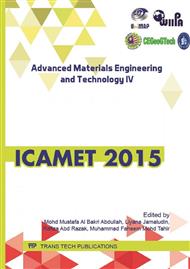[1]
D.F. Liu, Y.T. Jun, and W.L. Cong: Compos Struct Vol. 94 (2012), p.1265.
Google Scholar
[2]
N. Feito, J. Díaz-Álvarez, A. Díaz-Álvarez, J. L. Cantero and M. H. Miguélez: Mater Vol. 7 (2014), p.4258.
DOI: 10.3390/ma7064258
Google Scholar
[3]
D. Iliescu, D. Gehin, M.E. Gutierrez, F. Girot: Int J Mach Tool Manu Vol. 50(2) (2010), p.204.
Google Scholar
[4]
C.C. Tsao and H. Hocheng: Int J Mech Sci Vol. 49(8) (2007), p.983.
Google Scholar
[5]
A. Uysal, M. Altan, E. Altan: Int J Adv Manuf Tech Vol. 58(9-12) (2012), p.915.
Google Scholar
[6]
I. Singh, N. Bhatnagar and P. Viswanath: Mater Design Vol. 29 (2008), p.546.
Google Scholar
[7]
K. Debnath, I. Singh, A. Dvivedi and P. Kumar in: Recent advances in composite materials for wind turbine blades Edited by Dr. Brahim Attaf Advances in Materials Science and Applications, World Academic Publishing-Hong Kong (2013).
Google Scholar
[8]
E.D. Eneyew and M. Ramulu, J Mater Res Tech Vol. 3(4) (2014), p.354.
Google Scholar
[9]
M.P.D. Luis, M.R.S.T. Joao, G.M. Antonio, T.M. Antonio and P.M.B. Antonio.: Int J Mater Product Tech Vol. 32(2/3) (2008), p.226.
Google Scholar
[10]
Y.H. Guu, H. Hocheng, N.H. Tai and S.Y. Liu: J Mater Sci Vol. 36 (2001), p. (2037).
Google Scholar
[11]
J.Y. Sheikh-Ahmad: Mater Manuf Process (2015). DOI: 10. 1080/10426914. 2015. 1048368.
Google Scholar
[12]
H.M. Ali, A. Iqbal and M. Hashemipour: Indian J Eng Mater Sci Vol. 21 (2014), p.189.
Google Scholar
[13]
R. Kataria, J. Kumar and B.S. Pabla: Mater Manuf Process Vol. 30(7) (2015), p.921.
Google Scholar
[14]
H.M.A. Ibraheem, A. Iqbal and M. Hashemipour: J Chi Inst Eng Vol. 38(1) (2015), p.66.
Google Scholar
[15]
F. C. Campbell: Composite Materials (ASM International, Metals Park, Ohio, USA 2010).
Google Scholar
[16]
H.Y. Chan, A.B. Abdullah, Z. Samad and M.S.M. Zain: Int J Mater Eng Innov Vol. 6(4) (2015), p.288.
Google Scholar
[17]
Alicona. Alicona FOCUSvariation, Edition 4. 2013/2014; Available from: http: /issuu. com/alicona/docs/alicona_focusvariation_edition_4.
DOI: 10.17973/mmsj.2021_11_2021177
Google Scholar
[18]
A.B. Abdullah, S.M. Sapuan and Z. Samad: Int J Adv Manuf Tech Vol. 8 (2015), p.293.
Google Scholar


